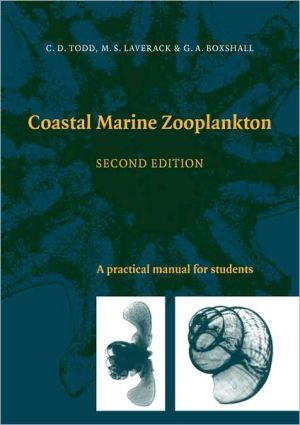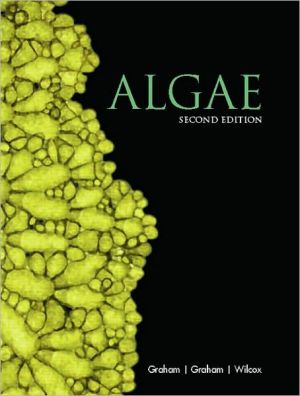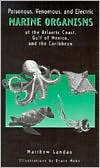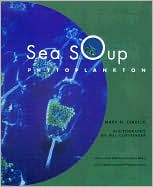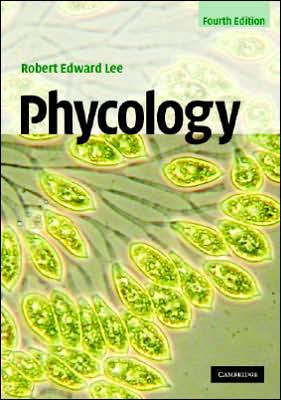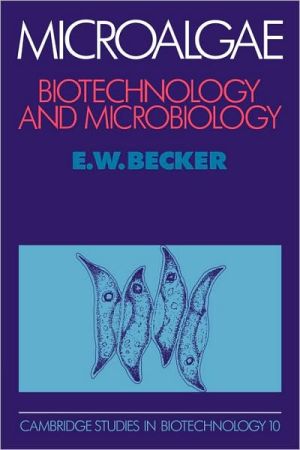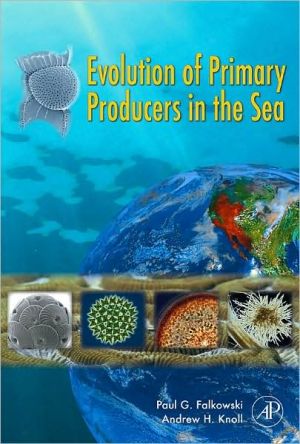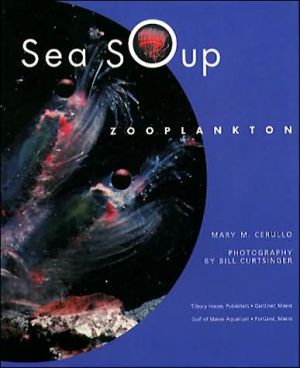Microbial Ecology of the Oceans
Like the successful first edition, Microbial Ecology of the Oceans, Second Edition is unique and fills a void in the rapidly growing fields of marine microbiology, microbial ecology, and microbial oceanography. Here, a carefully selected team of international experts explores issues of enduring importance to microbial ecologists, including: Genomes and metagenomes of marine microbes, Microbial evolution, as revealed by molecular techniques, Microbes in carbon budgets and cycles, Viruses and...
Search in google:
Nearly a decade since its landmark publication, Microbial Ecology of the Oceans has been thoroughly revised in this valuable new edition Like the successful first edition, Microbial Ecology of the Oceans, Second Edition is unique and fills a void in the rapidly growing fields of marine microbiology, microbial ecology, and microbial oceanography. Here, a carefully selected team of international experts explores issues of enduring importance to microbial ecologists, including: Genomes and metagenomes of marine microbes Microbial evolution, as revealed by molecular techniques Microbes in carbon budgets and cycles Viruses and grazers of bacteria Microbes and N cycle reactions in sediments The role of microbes in food web dynamics Biogeochemical cycles in the ocean In addition to drawing on the long history of microbiology, the contributors also include discussions of the latest advances in biological and chemical oceanography to examine the role of microbes and viruses in the oceans. Richly illustrated with black-and-white photographs and drawings, and complemented with a comprehensive list of additional reading for each chapter, this important new edition provides readers with current information in the fields of marine microbiology and microbial ecology. It is designed for students and researchers in biological and chemical oceanography, geochemistry, marine chemistry, freshwater ecology, and general microbiology. It is also appropriate for professionals and advanced students in related fields. SciTech Book News The collection brings together concepts from autoecological studies of individual bacterial groups and from ecological studies of microbial assemblages.
Preface xvContributors xviiIntroduction and Overview David L. Kirchman 1Eukaryotic Phytoplankton and Cyanobacteria 3Photoheterotrophic Bacteria 5Dissolved Organic Material 7Heterotrophic Bacteria 10Marine Archaea 13Heterotrophic Protists 14Nanoflagellates (2-20 [gamma]m) 14Microzooplanktonic Protists (20-200 [gamma]m) 16Dinoflagellates 16Marine Fungi 16Marine Viruses 17N[subscript 2] Fixers 18Nitrifiers and Other Chemolithotrophs 19Denitrifiers 20Concluding Remarks 21Summary 22Acknowledgments 22References 23Understanding Roles of Microbes in Marine Pelagic Food Webs: A Brief History Evelyn Sherr Barry Sherr 27Introduction 27Pre-1950s: The Early Years 281950-1974 291970s-1980s 32Improvement in Methods 32Bacterial Abundance 32Bacterial Activity 33Marine Heterotrophic Protists 34The "Microbial Loop" 361990-Present: The Molecular Revolution 39Summary 40References 41Bacterial and Archaeal Community Structure and Its Patterns Jed A. Fuhrman Ake Hagstrom 45Introduction 45Major Groups of Prokaryotes in Seawater 47"Classically" Culturable Bacteria 49The Roseobacter Clade of Marine Alphaproteobacteria 50Gammaproteobacteria 51Bacteroidetes 52Cyanobacteria 52"Sea Water" Culturable Bacteria 55SAR11 Cluster 55Not-Yet-Cultured Bacteria 57Marine Gammaproteobacterial Clusters 57Actinobacteria 58SAR116 Cluster 59SAR202 59Marine Group A 59Marine Group B 59Betaproteobacteria 59Marine Archaea 60Bacterioplankton Diversity 63Species Concept 63Microdiversity 64Components of Diversity: Richness and Evenness 65Community Structure: Description and Factors 67Bottom-Up Control 68Sideways Control 69Top-Down Control 70"Kill the Winner" Hypothesis 71Temporal Variation (Days to Seasonal) 72Short-Term Variation 72Seasonal Variation 72Spatial Variation 74Microscale Patterns 74Global Distribution 75Latitudinal Gradient and Degree of Endemism 76Patchiness and Large Eddies 77Summary 79References 80Genomics and Metagenomics of Marine Prokaryotes Mary Ann Moran 91Introduction 91The Basics of Prokaryotic Genomics 92Genome Sequence and Assembly 92Finding Genes 95Finding Operons 96Functional Annotation 96Tame or Wild? Pure-Culture Genomics Versus Metagenomics 100Genomics in Marine Microbial Ecology 103The Ecology of Genome Composition 103Reverse Biogeochemistry: Discovery of New Ecological Processes 104Environmental Reductionism: New Details About Recognized Processes 106Comparative Genomics and Metagenomics 107Future Directions 122Summary 125Acknowledgments 125References 125Photoheterotrophic Marine Prokaryotes Oded Beja Marcelino T. Suzuki 131Introduction 131Facultative Photoheterotrophy by Unicellular Cyanobacteria 132Cyanobacteria as Facultative Heterotrophs 132Uptake of Urea and DMSP 133Uptake of Nucleosides and Amino Acids 134Field Studies Using Light and Dark Incubations 135Implications of Facultative Photoheterotrophy by Cyanobacteria 138Marine AAnP Bacteria: Habitats and Diversity 139Rediscovery of the Marine AAnP Bacteria 139Diversity of AAnP Bacteria 139Physiology of AAnP Bacteria 140AAnP Bacterial Abundance and Ecological Significance 142Proteorhodopsin-Containing Prokaryotes 143Proteorhodopsin Genotypes and Taxonomic Distributions 144Proteorhodopsin Spectral Tuning 145Proteorhodopsin-Containing Prokaryotes: Abundance and Activity 146Proteorhodopsin-Containing Prokaryotes: Ecological Significance 150Summary 151References 151Ecology and Diversity of Picoeukaryotes Alexandra Z. Worden Fabrice Not 159Introduction 159Functional Roles, Classification, and Biological Traits 162Photoautotrophs 163Heterotrophs and Alternative Lifestyles 170Environmental Diversity and Molecular Phylogenetics 172Diversity of Uncultured Populations 174Methodological Issues for envPCR Studies 178Distribution, Abundance, and Activities 179Methods for Quantifying Mixed Assemblages 180Distribution, Abundance, and Activity of Mixed Picophytoplankton Assemblages 182Quantifying Specific Picoeukaryote Populations 186Methodological Challenges to Quantifying Specific Populations and Resolving Dynamics 190Mortality, Contributions to Microbial Food Webs, and Microbial Interactions 191Genomic Approaches to Picoeukaryote Ecology 193Integration of Picoeukaryotes to the Microbial Food Web: Research Directions 194Summary 195Acknowledgments 196References 196Organic Matter-Bacteria Interactions in Seawater Toshi Nagata 207Introduction 207Organic Matter Inventory and Fluxes 208DOM-Bacteria Interactions 211Labile Low-Molecular Weight (LMW) DOM 211Extracellular Hydrolytic Enzymes 215Polymeric DOM-Protein as a Model 217Refractory DOM 220POM-Bacteria Interactions 223POM Continuum 223POM Fluxes 223POM-Mineral Interactions 229Bacterial Community Structure and Utilization of Organic Matter 230Future Challenges 231Summary 232References 232Physiological Structure and Single-Cell Activity in Marine Bacterioplankton Paul A. del Giorgio Josep M. Gasol 243Introduction 243Distribution of Physiological States in Bacterioplankton Assemblages 245The Concept of "Physiological Structure" of Bacterioplankton Assemblages 245Starvation, Dormancy, and Viability in Marine Bacterioplankton 246Describing the Physiological Structure of Bacterioplankton 250Single-Cell Properties and Methodological Approaches 250Operational Categories of Single-Cell Activity 259Regulation of Physiological Structure of Marine Bacterioplankton 260Factors Influencing Physiological State of Bacterial Cells in Marine Ecosystems 261Factors Influencing Loss and Persistence of Physiological Fractions 263Distribution of Single-Cell Characteristics in Marine Bacterioplankton Assemblages 265Distribution of Single-Cell Activity and Physiological States in Marine Bacterioplankton 265Simultaneous Determination of Several Aspects of Single-Cell Activity and Physiology 270Patterns in Distribution of Single-Cell Activity and Physiology Along Marine Gradients 271Distribution of Activity and Growth Among Bacterial Size Classes 273Distribution of Activity Across and Within Major Phylogenetic Groups 274Dynamics of Single-Cell Activity and Physiological States 276Ecological Implications of Patterns in Bacterioplankton Single-Cell Activity 279Community Versus Individual Cell Growth and Metabolic Rates 280Linking the Distribution of Single-Cell Parameters and the Bulk Assemblage Response 282Ecological Role of Different Physiological Fractions 283Concluding Remarks 284Summary 285Acknowledgments 285References 285Heterotrophic Bacterial Respiration Carol Robinson 299Introduction 299Measurement of Bacterial Respiration and Production 301Routine Measurement Techniques for Bacterial Respiration and Their Limitations 301Routine Measurement Techniques for Bacterial Production and Their Limitations 304Magnitude and Variability of Bacterial Respiration 304Temporal Variability 308Spatial Variability 309Relationship Between Bacterial Respiration and Environmental and Ecological Factors 311Bacterial Respiration as a Proportion of Community Respiration 315Predicting Bacterial Respiration 317Comparison Between Measurements and Predictions of Bacterial Respiration 319Magnitude of Bacterial Respiration in Relation to Primary Production 321Bacterial Respiration in a Changing Environment 324Summary 326Acknowledgments 327References 327Resource Control of Bacterial Dynamics in the Sea Matthew J. Church 335Introduction 335Growth in the Sea 336Growth and Nutrient Uptake Kinetics 339Approaches to Understanding Resource Control of Growth 343Comparative Approaches 343Experimental Approaches for Defining Limitation of Bacterial Growth 349Limitation by Dissolved Organic Matter 351Bacterial Growth on Bulk DOM Pools 353Limitation by Specific DOM Compounds 354Limitation by Inorganic Nutrients 361Nitrogen 361Phosphorus 364Trace Nutrients 365Temperature-DOM Interactions 366Light 368Resource Control of Specific Bacterial Populations in the Sea 369Summary 371Acknowledgments 371References 371Protistan Grazing on Marine Bacterioplankton Klaus Jurgens Ramon Massana 383Introduction 383New Insights into Phylogenetic Organization 386Functional Size Classes of Protists 390Natural Assemblages of Marine Heterotrophic Nanoflagellates 391Functional Ecology of Bacterivorous Flagellates 394Living in a Dilute Environment 394Using Culture Experiments to Infer the Ecological Role of HNF 397Impact of Protistan Bacterivory on Marine Bacterioplankton 401Search for the Perfect Method to Quantify Protistan Bacterivory 401Rates of Protistan Bacterivory in the Sea 403Balance of Bacterial Production and Protistan Grazing 404Bottom-Up Versus Top-Down Control of Bacteria and Bacterivorous Protists 405Ecological Functions of Bacterial Grazers 406Grazing as a Shaping Force of Bacterial Assemblages 408Bacterial Cell Size Determines Vulnerability Towards Grazers 408Other Antipredator Traits of Prokaryotes 411Grazing-Mediated Changes in Bacterial Community Composition 414Molecular Tools for Protistan Ecology 414Culturing Bias and Molecular Approaches 414Global Distribution and Diversity of Marine Protists 420Linking Diversity and Function for Uncultured Heterotrophic Flagellates 422Summary 423Acknowledgments 424References 424Marine Viruses: Community Dynamics, Diversity and Impact on Microbial Processes Mya Breitbart Mathias Middelboe Forest Rohwer 443Introduction 443Viruses and the Marine Microbial Food Web 444Direct Counts and Viral Numbers 444Viral Production and Decay Rates 447Viral Decay and Rates of Production in Pelagic Systems 447Measurements of Viral Production in Marine Sediments 449General Rates of Viral Production 449Role of Viruses in Biogeochemical Cycling 450Impact of Viruses on Bacterial Diversity and Community Dynamics 452Marine Viral Diversity 457Methods for Examining Marine Viral Diversity 457Culture-Based Studies of Viral Diversity 458The Need for Culture-Independent Methods 459Culture-Independent Studies of Viral Diversity Using Transmission Electron Microscopy 460Whole-Genome Profiling of Viral Communities Based on Genome Size 461Studies of Viral Diversity Using Signature Genes 461Metagenomic Studies of Viral Diversity 462A Vision for the Future 466Summary 467References 468Molecular Ecological Aspects of Nitrogen Fixation in the Marine Environment Jonathan P. Zehr Hans W. Paerl 481Introduction 481Chemistry, Biochemistry, and Genetics of N[subscript 2] Fixation 482Genetics and Enzymology 483Evolution of N[subscript 2] Fixation 485Phylogeny of Nitrogenase 487Genomics of N[subscript 2] Fixation 487Diversity of N[subscript 2]-Fixing Microorganisms 489Regulation in Diazotrophs 489Methods for Assessing Diazotroph Diversity, Gene Expression, and N[subscript 2] Fixation Activity 490Ecophysiological Aspects of N[subscript 2] Fixation 494Ecology of Diazotrophs in the Open Ocean 499Estuarine and Coastal Waters 505Benthic Habitats, Including Microbial Mats and Reefs 506Deep Water and Hydrothermal Vents 507Summary 508Acknowledgments 509References 509Nitrogen Cycling in Sediments Bo Thamdrup Tage Dalsgaard 527Introduction 527Inputs 531Transformations 532Microbes and Microbial Processes 532Processes Involving Mn and Fe 548Nitrogen Budgets 550Benthic Budgets 550Oceanic Budgets 552Summary 554References 555Index 569
\ Choice...useful resource for everybody working in this field...well-written material and simple and lucid illustrations...would serve as an excellent primary source of information on virtually any aspects of marine microbial ecology.\ \ \ \ \ SciTech Book NewsThe collection brings together concepts from autoecological studies of individual bacterial groups and from ecological studies of microbial assemblages.\ \ \ Choice...useful resource for everybody working in this field...well-written material and simple and lucid illustrations...would serve as an excellent primary source of information on virtually any aspects of marine microbial ecology.\ \ \ \ \ BooknewsSummarizes basic information known about microbes as components of the food webs and elemental cycles at work in the oceans. The collection brings together concepts from autoecological studies of individual bacterial groups and from ecological studies of microbial assemblages. Topics of the 16 contributions include microbial evolution as revealed by molecular techniques, microbes in carbon budgets and cycles, control of bacterial growth in idealized food webs, the impact of viruses on bacterial processes, interactions between bacteria and their grazers, the marine microbial nitrogen cycle, and symbiosis and mixotrophy among pelagic microorganisms. Annotation c. Book News, Inc., Portland, OR (booknews.com)\ \ \ \ \ From the Publisher"The collection brings together concepts from autoecological studies of individual bacterial groups and from ecological studies of microbial assemblages." (SciTech Book News, Vol. 25, No. 2 June 2001)\ "...useful resource for everybody working in this field...well-written material and simple and lucid illustrations...would serve as an excellent primary source of information on virtually any aspects of marine microbial ecology." (Choice Vol. 38, No. 9 May 2001)\ "...this is an excellent book...will serve as an authoritative source on bacterial life in the water column...I recommend it warmly to anyone interested in biological oceanography and the microbial life in the sea." (Journal of Experimental Marine Biology and Ecology, Vol. 269, 2002)\ \ \

